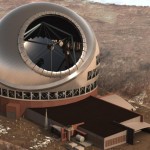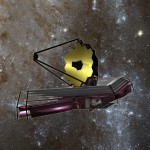There is an article on the TMT in yesterdays’s Honolulu Advertiser. While the article shows growing community awareness of the Thirty Meter Telescope project and puts forth some of the basics, it concentrates on some of the political issues. Those are, as typical for Hawai’i, rather fractious, showing the very polarized nature of political discourse in the state.

One of the themes that popped up in the comments several times was the idea that space telescopes are where to put the money and the belief that ground telescopes were “obsolete’, thus projects like TMT are not needed. This could not be further from the truth. Yes there are advantages to space telescopes with respect to interference from the atmosphere. But space telescopes face several severe and inherent disadvantages.
Expense: Space telescopes are hugely expensive for what you get. Hubble is a mere 2 meter class telescope. Very small in the terms of modern telescopes. This limits the performance drastically. Hubble can only collect a little more light than a single segment of the current Keck telescope, and Keck has 36 segments in it’s 10 meter mirror. Work out the math and you find that Keck gathers 25 times more light than than Hubble. The new James Webb Space Telescope will be a 6.5 meter telescope. The Thirty Meter Telescope will be 30 meters with 492 segments, thus will gather 28 times more light than JWST.
Access: Competition for time on the Hubble telescope is intense, there are only so many hours available and the number of applications to use that time is vastly greater than the time available. This tends to eliminate programs that take large amounts of telescope time, and some of those programs have proven to be the most productive from a scientific standpoint. Several ground based telescopes can be built for the same cost as a single space telescope, this means more astronomers can get time and far more science can be accomplished. Keck is scientifically the most productive telescope in the world, or off the world. More science papers are written based on Keck data than any other telescope in operation.

It will not be possible to service the James Webb Space Telescope, as it will be located in an orbit 1 million miles from Earth, four times the distance of the Moon and far beyond the reach of the Shuttle.
Upgrade: Science changes, we learn what works or does not work and adapt the telescope to fit. With a space telescope you are stuck with what you launch until a service mission can be launched. You can not change or reconfigure the instrument to a new role or to exploit any new discoveries. Ground based telescope are reconfigured daily and instruments are continuously updated or replaced.
Adaptive Optics: Modern ground based telescopes have overcome many of the limitations of peering through the atmosphere through the use of adaptive optics systems. Keck, Gemini, Subaru and similarly equipped large telescopes can see more sharply than Hubble using the combination of a larger mirror and adaptive optics. And these systems are currently being upgraded to even higher levels of performance. TMT will utilize such a system as part of its basic design from initial conception.
The result is that the current Webb telescope, or any other seriously proposed space telescope can not come close to replacing what TMT will do for our understanding of the universe. A good space based telescope can be very valuable to science, but in any subjective measure of cost effectiveness, flexibility or capability for maintenance and upgrade a large ground based telescope wins. In practical use both types of telescopes complement each other, allowing each telescope to do what it does best. Often data from several types of telescope is used together to penetrate the riddles of our universe.

